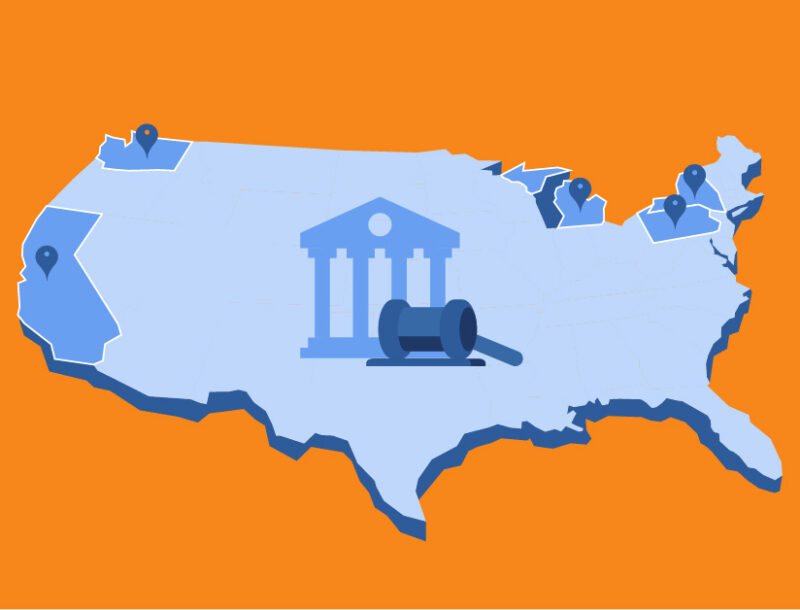Expert Insights: The CFPB’s Impact in 2023 and Beyond

Facing another record-breaking year of consumer complaints in 2023, the consumer finance industry faces a pivotal crossroads. This surge, along with intensified rulemaking and activities from the CFPB, signals unprecedented regulatory and compliance pressures.
In a recent webinar, we had the privilege of being joined by two esteemed CFPB alumni to hear their fresh perspectives.
Gary Stein, Partner and Chief Portfolio Officer at 99Fintech, previously led policymaking efforts related to consumer payments, deposits, unsecured credit, and data aggregation at the CFPB. Melissa Baal Guidorizzi, Partner at Orrick, Herrington & Sutcliffe LLP, previously worked in the CFPB’s Office of Enforcement, where she developed supervision and enforcement priorities, identifying subjects for examinations and investigations.
This jam-packed discussion covered topics such as the significant rise in consumer complaint volume in 2023, leveraging consumer complaint data in internal compliance processes, the paradox of decreased enforcement actions but increased enforcement power, the impact and value of these actions for the CFPB, new challenges facing CCOs, the CFPB’s notable rulemaking surge in 2023, and expectations for the Bureau in 2024.
Key Takeaways
- Fewer enforcement actions, increased enforcement power: While the quantity of public enforcement actions has decreased in recent years, the Bureau’s overall enforcement power has actually increased by using the full arsenal of tools available to them.
- Expect increased CFPB activity in 2024: The CFPB is anticipated to be highly active in 2024, focusing on more punitive regulations and increased enforcement actions, reflecting its expanded authority and strategic direction.
- Adopt a proactive and strategic approach to compliance: Companies in the consumer finance sector should adopt a proactive approach to compliance, including leveraging consumer complaint data and employing strategic compliance methods to prepare for upcoming regulations in a high-interest rate environment.
- The significant rise in consumer complaint volume in 2023
- Leveraging consumer complaint data in internal compliance processes
- Enforcement actions are down, but enforcement power has increased
- The impact and value of enforcement actions for the CFPB
- Navigating new challenges for Chief Compliance Officers
- The CFPB’s rulemaking surge in 2023
- Expectations for the CFPB in 2024
The significant rise in consumer complaint volume in 2023
One of the most notable trends we’ve seen in recent years is the significant increase in consumer complaint volume. Consumers submitted almost 500k complaints to the CFPB in 2021, 800k in 2022, and already over 1 million in 2023. In fact, the number of complaints submitted in 2022 and 2023 accounts for 43% of all complaints received by the CFPB since its establishment in 2011.
This increase goes beyond just the increase in the number of organizations under the scope of the CFPB. It also reflects the impact of macroeconomic events, consumer experiences in the marketplace, and the growth of the CFPB into a key regulator in the space.
Macroeconomic factors and consumer experiences
The COVID-19 pandemic in 2021 brought stimulus payments and a boom in online transactions, but these didn’t immediately translate into a spike in complaints. However, the post-pandemic period has been marked by rising debt, stagnant wages, and challenging economic conditions. As all of these factors are causing consumers to face increasing hardships, both Gary and Melissa agreed that it could be contributing to the increase in complaints.
We’ve also seen trends of increased use of available credit lines and a rise in delinquencies, which could be leading to more disputes and frustration, particularly among subprime borrowers, who may be finding it more challenging to access credit and pay off their debts.
The same holds true for payments, says Gary. Major payment providers, both established and emerging, are continuing to experience significant growth. This means there’s a greater volume, and even when things generally go smoothly, it still creates more opportunities for issues to arise.
On the credit front, a significant portion of the complaints in 2023 revolved around credit bureaus and credit reporting, specifically regarding credit report inaccuracies and misuse. Since creditworthiness crucially affects consumers’ purchasing power and daily lives, issues in this area are likely a driving contributor to the increased complaints.
Consumer awareness of the CFPB and its growth into a key regulator in the space
Another key factor to note regarding the increase in consumer complaints is that the CFPB has made significant progress in its 12-year existence.
The CFPB has grown into a key regulator in the consumer finance industry and has successfully educated consumers about their rights and avenues for complaints.
It started out as a startup federal agency, where sometimes I would call another federal agency, and they didn’t know who we were. And now, the CFPB has succeeded in brand recognition and letting people know more about what their rights are and where they can complain.
– Melissa Baal Guidorizzi, Orrick
It’s worth considering that increased complaint volumes might be due to greater awareness of the system, says Melissa.
The CFPB was born out of the last major recession in 2008. As we’re heading into another year of a tough economy for consumers—high interest rates, rising debt, and student loans still lingering—the need for consumer protection is critical.
Leveraging consumer complaint data in internal compliance processes
Consumer complaints are more than just feedback; they represent an early warning system for potential regulatory issues. It’s one thing to be aware of consumer complaints, but it’s another thing to be organized and methodical about how to leverage this information.
What truly matters to everyone in this ecosystem is the wealth of available data. State and federal regulators, plaintiffs’ attorneys, and others leverage the consumer complaint database to identify areas of focus. Companies should do the same, as this dataset provides valuable insights for continuous product and service improvement.
– Melissa Baal Guidorizzi, Orrick
Analyzing trends in consumer complaints is crucial. It helps businesses understand which products or services generate more complaints and thus might attract regulatory scrutiny, investigations, or Civil Investigative Demands (CIDs).
Trend analysis is also valuable for evaluating the performance of your staff and systems in handling customer service, says Melissa. Customer service has become an increasingly significant focus for all regulators, particularly the CFPB. How promptly and effectively you respond to your customers can greatly assist in mitigating risks and ultimately improving your market share and portfolio performance.
If you’re not attuned to this information, you’re putting on blinders that forget about regulatory risk and consumer harm. You’re just doing a disservice to your business and your revenue potential.
— Gary Stein, 99Fintech
Gary talked about how there’s often a debate about the definition of a “complaint.” While a clear definition is essential for compliance, maintaining a broader perspective is more beneficial for internal management.
Consumers might call in with polite inquiries or express confusion about a product or service without necessarily being angry. These instances are crucial risk signals because, for every customer who contacts you, there are likely dozens or more who do not but may still have concerns. Some may choose to remain silent, while others may consult plaintiff attorneys and explore various avenues. Focusing on the overall customer experience and their feedback is vital.
So, it’s not just about having a game plan for addressing and reporting complaints. The ultimate goal is not just simply demonstrating to regulators that an organization cares; it’s about taking concrete actions to address these issues and truly “walk the walk,” says Gary.
Enforcement actions are down, but enforcement power has increased
Another notable trend from the CFPB is that the number of public enforcement actions has decreased in recent years, but consumer relief increased significantly. This shift raises important questions about the Bureau’s evolving approach to enforcement.
Director Chopra’s strategic focus
Under Director Chopra’s tenure, there’s been a strategic shift towards targeting “big tech” and major market players rather than a broad spectrum of smaller cases. This change in focus necessitates increased enforcement resources and legal support.
Increased opposition and litigation
As the CFPB matures as an agency, it’s getting more pushback, explained Melissa. This pushback is coming from not only the ongoing Supreme Court deliberations regarding its constitutionality, but also because companies are becoming increasingly willing to oppose regulatory actions, leading to more litigation—all requiring an increased workforce.
Expanding supervision and enforcement reach
Another shift within the Bureau is that enforcement now extends beyond the confines of the Office of Enforcement. The current administration has been proactive in maximizing the authority granted by the Dodd-Frank Act. This includes expanding supervision over non-banks—regardless of market size—if they pose risks to consumers, and issuing rules to broaden jurisdiction for both supervision and enforcement.
Supervision has also become more detailed, accompanied by frequently asked questions (FAQs) and advisory opinions issued at a higher frequency. Additionally, the Director has reinvigorated the use of the “bully pulpit,” which involves making impactful public statements through speeches and blogs. Director Chopra is explicit about his objectives and expectations. So, when discussing enforcement, it’s crucial to consider these broader developments beyond just counting the number of cases in the traditional sense.
So, while the number of enforcement actions has seemingly decreased, the Bureau’s overall enforcement power has actually increased by using the full arsenal of tools available to them.
The impact and value of enforcement actions for the CFPB
With the 2024 presidential election looming, Gary discussed the value and impact that enforcement actions have on the industry, regardless of the current administration’s political affiliation.
He pointed out that we now have two data points with two changes in administration. In both cases, there was an initial dip as they assessed the previous administration’s initiatives and then reallocated resources according to their policy priorities.
I think every director at the Bureau, regardless of what side of the aisle they come from, has recognized the value in the measurability of enforcement actions. Quantifying rulemaking is less direct than an enforcement action. We can count off the billions of dollars that have been returned to consumers, and I think many directors have made sure that shows up at the bottom of every press release, and everything they put out. It’s a way to measure their legacy.
— Gary Stein, 99Fintech
Enforcement’s role in shaping policy
The Bureau needs to maintain a big-picture perspective because enforcement actions can impact and shape policy-making agendas, says Gary. When dealing with a player in the market whose actions need restraint, considerations arise about how it aligns with broader rulemaking objectives. As the Bureau continues to issue more rules, it’ll be interesting to observe how these dynamics evolve.
In the immediate aftermath of a rule’s implementation, we might see an uptick in enforcement actions as companies adjust to new obligations. However, over time, these rules should transition the market from a “wild west” scenario to a more regulated and consumer-friendly environment, potentially resulting in a decline in enforcement actions. But it’s worth noting that we might not yet have sufficient data to prove this.
Navigating new challenges for Chief Compliance Officers
In an era where the CFPB is adopting a more strategic approach, focusing on rulemaking and policy creation, Chief Compliance Officers (CCOs) face unique challenges. Many are navigating a high-interest rate environment, staffing reductions, and budget constraints. So, how can they prepare for upcoming rules and policy changes, especially with leaner teams?
Embracing automation and technology
Automation and technology can help relieve significant burdens from compliance teams.
This is an excellent market for using automation to enhance the ability of organizations to manage all of this. If you staff up to try and do everything manually, it would probably break the back of any business that’s trying to operate. It compels a lot of organizations to look for tools and intelligence that help them in their surveillance, management, resolution, and reporting.
– Gary Stein, 99FinTech
The concept of strategic compliance
Preparing for these changes requires what Gary refers to as “strategic compliance,” which involves being proactive and forward-thinking. It’s crucial to plan ahead, especially when you’re operating with lean staffing.
It’s better to plan ahead, so take the opportunity… Make a list of all the different things coming down the pipe. There are so many resources—there are law firms, there’s technology, there are consultants. Figure out what are the things that might impact your business and use a waterfall risk-based approach to how you need to tackle these challenges and what resources you need.
– Melissa Baal Guidorizzi, Orrick
Compliance as a business imperative
Ignoring compliance obligations in the consumer finance industry is not an option—compliance is a critical aspect of business growth and sustainability.
At PerformLine, we find that companies seek automation solutions either as a proactive measure or when scaling with existing resources becomes unsustainable. Our goal is to help companies avoid reaching a state where they’ve received a consent order—strategic planning is key to achieving that.
The CFPB’s rulemaking surge in 2023
In 2023, the CFPB has been notably active in areas like combating junk fees, as seen in Issue 29 of their Supervisory Highlights. They’ve proposed a rule that would accelerate the shift toward open banking, and they’ve also proposed a rule to supervise larger non-bank companies offering services like digital wallets and payment apps.
Tailoring focus based on your business
The focus on specific pending rules can vary depending on the organization, says Gary. Bigger organizations, for example, may be more focused on the larger participant rule. For companies in the bill pay sector or data brokers, the rules in place could significantly affect their operations.
The broader strategy behind rulemaking
These rules, Melissa explains, are part of a broader strategy. It’s evident that both data and payments are significant focuses for the CFPB, and they often go hand in hand. Data protection is a consumer protection concern across the board.
All of the things that are happening out of the Bureau now is an attempt to regulate the flow of both funds and consumer information. There are going to be issues for all players in the space related to how that plays out because funds and data don’t function the same way.
– Melissa Baal Guidorizzi, Orrick
For example, in the 1033 rule, there’s a lot about the limited collection of data only for what is necessary for a product or service, but data does more than that in this economy. A lot of companies rely on data for different functions, such as marketing, improvement of products, and user experience.
Expansion of CFPB authority
The larger participant rule aims to expand the CFPB’s examination authority to crypto and digital assets. This is important because it’s a “full court press” on expanding the Bureau’s jurisdiction over markets that are consumer-facing but maybe not as traditional as financial services.
It’s important to note that consumers have assets beyond just dollars in their bank accounts. Data is increasingly considered an asset, and it’s vital to ensure transparency and control over it, says Gary. Concepts like express informed consent and authorization are becoming more critical, and companies must align their practices with consumer expectations.
Navigating a complex financial landscape
The world is only going to become more complicated. As financial services and payment methods continue to evolve, it’s essential to interpret existing regulations with the spirit of consumer protection in mind. Anticipating consumer risks and addressing them proactively is key to staying compliant before regulators come knocking on your door.
Expectations for the CFPB in 2024
While we don’t have a crystal ball, we can likely expect a year of increased activity and significant developments at the CFPB in 2024.
I was talking with former colleagues that are still there [at the CFPB]. I think everybody there is quite busy, so don’t expect nothing.
– Gary Stein, 99FinTech
Gary emphasized the potential for more punitive regulations while also hoping for rules that support the business as a service (BaaS) model. This model, crucial for fostering effective collaboration between banks and fintechs, could significantly contribute to industry growth.
Melissa expects increased activity from the CFPB in various sectors, with more enforcement actions likely. The agency has expanded its staff, leading to more investigations, which could result in litigation or consent orders. Any significant announcements or actions in 2024 shouldn’t come as a surprise.
There’s a big push, I think, at the CFPB to lock in the gains of some of the work that’s been done over the past few years. I think you’ll see that through advisory opinions or more rulemaking. Supervision is going to continue to note the dollars and cents it gets back on their exams. We’re seeing examiners are asking for more and more money back from exam subjects.
– Melissa Baal Guidorizzi, Orrick
There are several key areas that are likely to see progress. The CFPB’s ongoing rulemaking activities include scrutinizing the Buy Now, Pay Later (BNPL) industry, with data collection still pending. Rules like Section 1033 and the Fair Credit Reporting Act (FCRA) are also expected to evolve, with possible notices of proposed rulemaking on the horizon. Overdraft policies are particularly likely to receive attention, reflecting the CFPB’s commitment to solidifying gains from past efforts.
While there will indeed be increased activity, it’s worth noting that the CFPB has a finite capacity for rulemaking, as these processes require meticulous attention to detail, data-driven evidence, and extensive public input, explains Gary. Legal challenges may also arise, further slowing down rule implementation.
In this context, staying informed is key. Keeping an eye on the regulatory agenda can offer early indicators of upcoming changes. Preparing for these regulatory shifts is essential, whether through staffing adjustments, proposing new technology, or enhancing regulatory change management practices.
The impact of a potential administration change
With the 2024 election on the horizon, the potential for an administration change raises questions about the future direction of the CFPB.
While the depth of examinations and the likelihood of enforcement actions might vary with a change in administration, the CFPB’s core principle of ensuring fair treatment for consumers should not be compromised, says Gary. It’s crucial to maintain focus on consumers’ best interests.
If the Democrats remain in power, it’s possible that Director Chopra might eventually move on since directors serve a maximum 5-year term. The regulatory focus may shift, though, depending on what rules go into place.
Melissa emphasized the role of career staff at the CFPB. Many have been there since its inception and are focused on ensuring continuity in the work and the pipeline of initiatives. The foundational work will persist, regardless of the top-level changes. So it’s crucial not to let up on compliance and adherence to regulatory obligations.
Moreover, the Bureau’s expanded authority and jurisdiction will remain in place. Directors may change, but the tools available to the CFPB continue to be essential for consumer protection. Different leaders may employ these tools in various ways, but they’ll remain available.
Consumers should always come first
The bottom line is that the CFPB was founded for the purpose of helping consumers take control of their financial lives.
As consumers are heading into another year of uncertainty, with high interest rates and increasing debt, it’s important for consumer finance companies to keep consumer protection top of mind.
PerformLine is here to help consumer finance companies navigate these challenges and be proactive in their compliance efforts. Through comprehensive marketing compliance monitoring, PerformLine empowers organizations to stay ahead of regulatory changes and mitigate risks efficiently.
Learn more about how PerformLine can help. Request a demo today.



